はじめに
キャビネットの金物は、あなたの家の輝きです。キッチンやバスルーム、家具を華やかなものに変身させる最後のアイテムです。さまざまな素材がある中で、ステンレススチール製のキャビネット金具は、なめらかで耐久性に優れ、用途が広いため、住宅所有者にもデザイナーにも人気があります。このガイドでは、ステンレススチール金具の選び方、取り付け方、お手入れ方法など、必要な知識をすべてご紹介します。一般的な俗説を覆し、デザインの可能性を議論し、プロとしてのアドバイスを提供します。
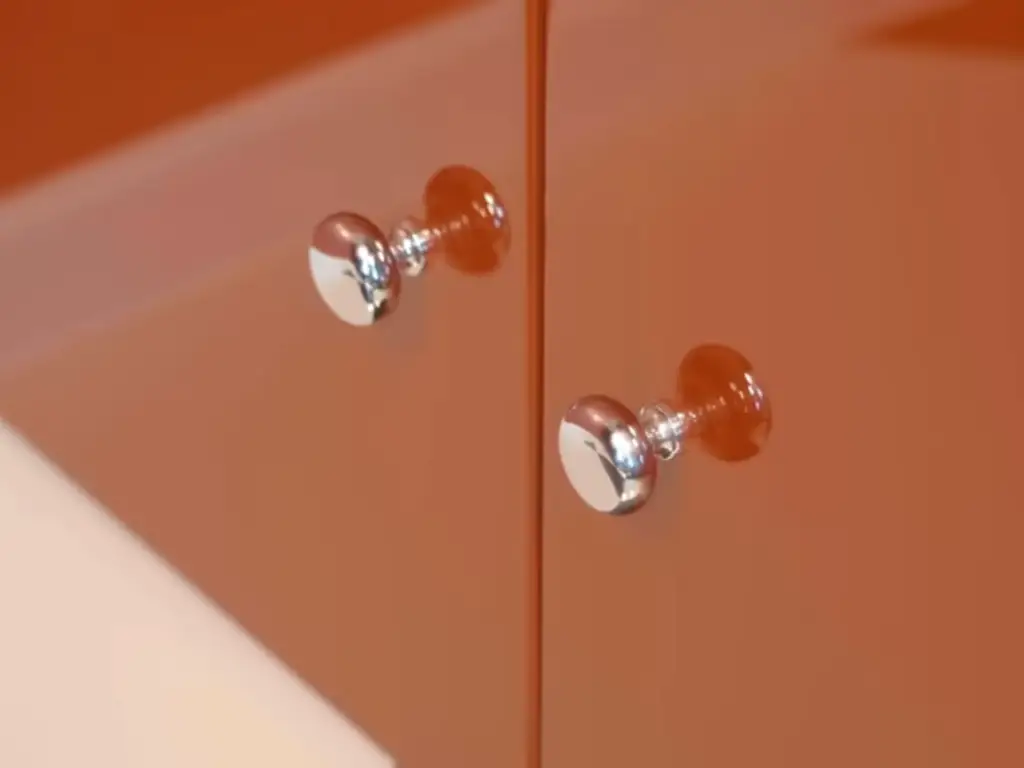
キャビネットのスタイルを決めるのはノブと引手ですが、その機能性を決めるのは、目に見えない金物の品質です。その中心的な役割を果たすのが、スムーズな動きと荷重を支えるヒンジと引き出しのスライドです。このような動きの多い部品には、錆や磨耗を避けるため、ステンレススチールのような長持ちする素材が必要です。そうすれば、美しいキャビネットは何年経っても機能的で、不満を感じることなく使い続けることができます。
キャビネット金物用ステンレス鋼について
ステンレス・スチールを使うという決断は簡単なように思えるかもしれませんが、ステンレス・スチールという名称自体が、さまざまな特性を持つ合金を含む包括的な用語なのです。キャビネットの金物を長持ちさせ、機能的にするためには、これらの違いを理解することが大切です。
成績に関するよくある神話を覆す
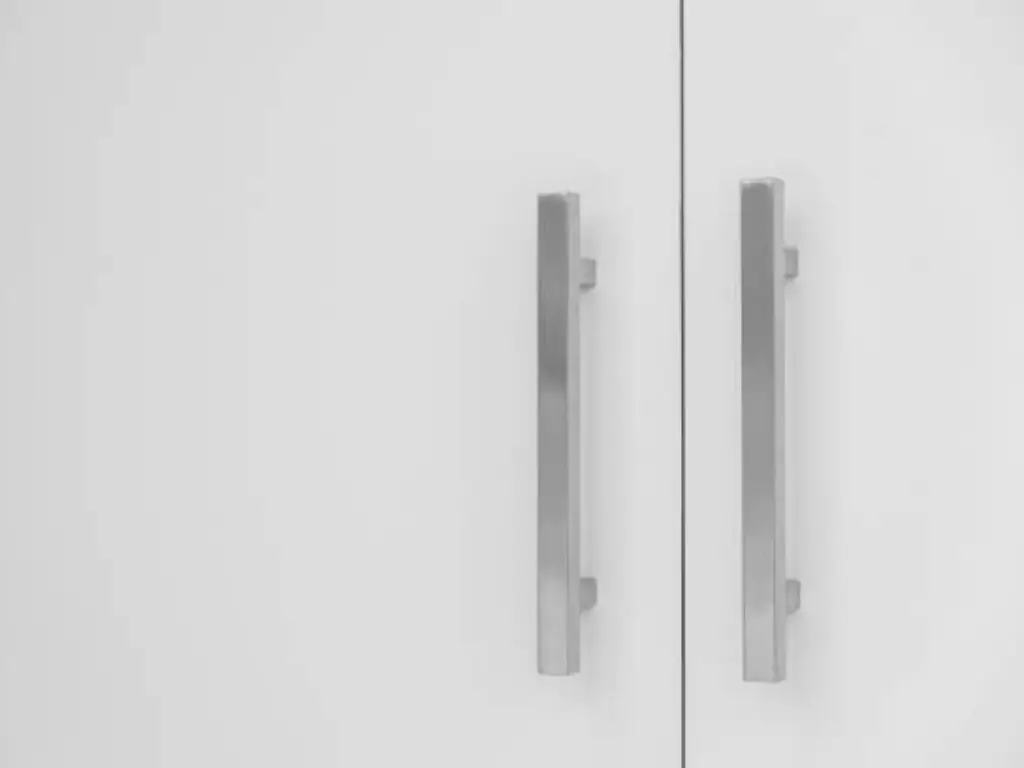
金物業界最大の神話は、キャビネットの金物は304や316といった高級グレードのものしか使われていないというものだ。実際には、ほとんどのメーカーがコスト面から異なる等級で製造しています。1つの等級がすべての用途に適合すると考えるのではなく、それぞれの等級が何ができるのか、どこで最も適用できるのかを知ることが重要です。
200シリーズステンレス鋼(例:201、202): 低ニッケル合金で、コスト削減のためニッケルの一部をマンガンと窒素で置換している。304よりも硬く安価だが、耐食性はかなり劣る。201ステンレス鋼は、湿潤または汚染された条件下で非常に錆びやすい。それは頻繁にお金を節約するために非常に安価なステンレス鋼のノブやキャビネットの引手に適用されます。それは304に似ていますが、それははるかに少ない耐久性と長期的な機能を持っているので、消費者は用心する必要があります。
400シリーズステンレス鋼(例:430、410、420): これらはニッケルをほとんど含まない合金で、クロムと鉄で構成されている。主な特徴のひとつは、304や316と異なり磁性を持つことである。
- 430ステンレス鋼: 典型的な低コストの鋼種である。304ほど耐食性、成形性に優れませんが、201よりは錆を防ぐのに適しています。電化製品の外装に使用されることが多く、安価なドアハンドルやキャビネット金物の内部部品に使用されることもあります。
- 410/420ステンレス鋼: これらの鋼種は、その並外れた硬度と耐摩耗性により高く評価されており、ネジやナイフなど、耐食性ではなく耐久性が求められる高強度用途に使用されている。
300シリーズステンレス鋼(例:304、316): これらの合金は、優れた耐食性を提供する高いニッケル含有量が特徴である。
- 304ステンレス鋼: キッチンやバスルームのような適度な湿気のある環境では、高品質のキャビネット金物の金字塔です。錆や汚れに強いので、良い投資となります。
- 316ステンレス鋼: 一般にマリーングレードと呼ばれ、モリブデンを含むため最も耐食性が高い。通常、沿岸地域などの過酷な条件で使用され、高価なため一般的な屋内キャビネットの金物にはほとんど適用されない。
要するに、最適な鋼種は純粋に用途と予算 の問題である。201および400シリーズ・ステンレ ス鋼は、費用対効果の高い金物の代表的な鋼種で あるが、304ほどの耐久性はない。ステンレス鋼はどれも同じという俗説を信じず、使用環境と予算に応じて選択しましょう。優良なメーカーであれば、使用するステンレス鋼のグレードの詳細を明確に説明します。
ニーズに合ったグレードを見つける
正しい選択をするために、以下のことを考慮しよう:
- 乾燥した室内環境用: 湿気の少ない居間や寝室では、201または430ステンレススチールの金物が費用対効果に優れ、まったく適切な選択となる。
- キッチンとバスルーム用: 304グレードは、蒸気、水、その他の洗浄薬品が存在するため、キャビネット金物に最も適しています。耐食性が向上しているため、安心してお使いいただけ、金具の仕上げが損なわれることもありません。
- 水分の多い地域や沿岸地域向け: 通常とは異なる高湿度の環境にいる場合、あるいは海の近くに住んでいる場合は、錆や孔食の可能性を避けるために316グレードを検討する価値があるかもしれないが、これは特殊なケースである。
ステンレス金物の仕上げを探る
仕上げは、ステンレススチール製キャビネット金具の外観と使用感を決める最後の仕上げです。見た目の美しさだけでなく、仕上げは金具の日常的な使い勝手やお手入れのしやすさにも影響します。
さまざまな仕上げの見た目と感触

ブラッシュドステンレススチール: これはおそらく、現在最も一般的なステンレス・スチール仕上げである。細かいワイヤーブラシやサンディングベルトで表面を磨くかサンディングし、小さな平行線を形成します。その結果、マットでソフトな光沢が生まれ、モダン・エレガントな雰囲気になります。ブラッシュド・ステンレススティールは、滑らかな手触りのソフトな質感です。この仕上げは、モダンでインダストリアルなデザインに見事にマッチし、ほとんどのモダンな電化製品に理想的にマッチします。
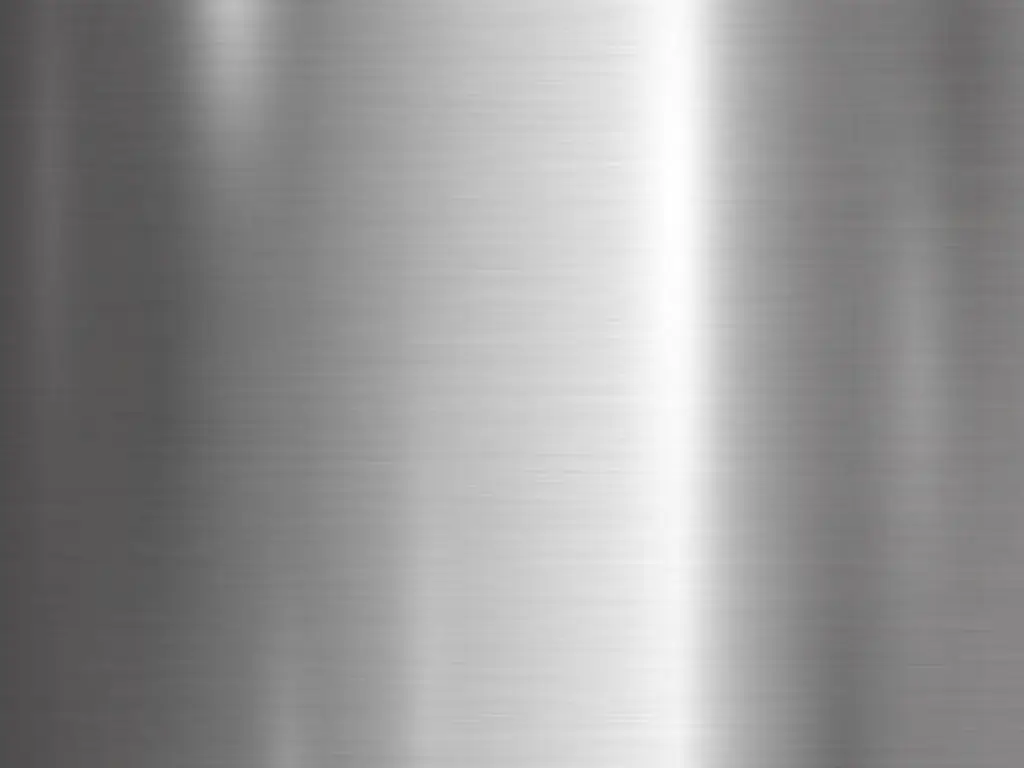
ポリッシュ仕上げのステンレススチール: これは非常に光沢のある仕上げで、明るい鏡のように見える。金属を磨いて光沢を出すのです。ポリッシュ仕上げのステンレススチールは、空間に洗練さと華やかさを与える大胆な決断です。高級キッチンやアール・デコ調のデザインなど、フォーカルポイントを作りたい場所に効果的です。
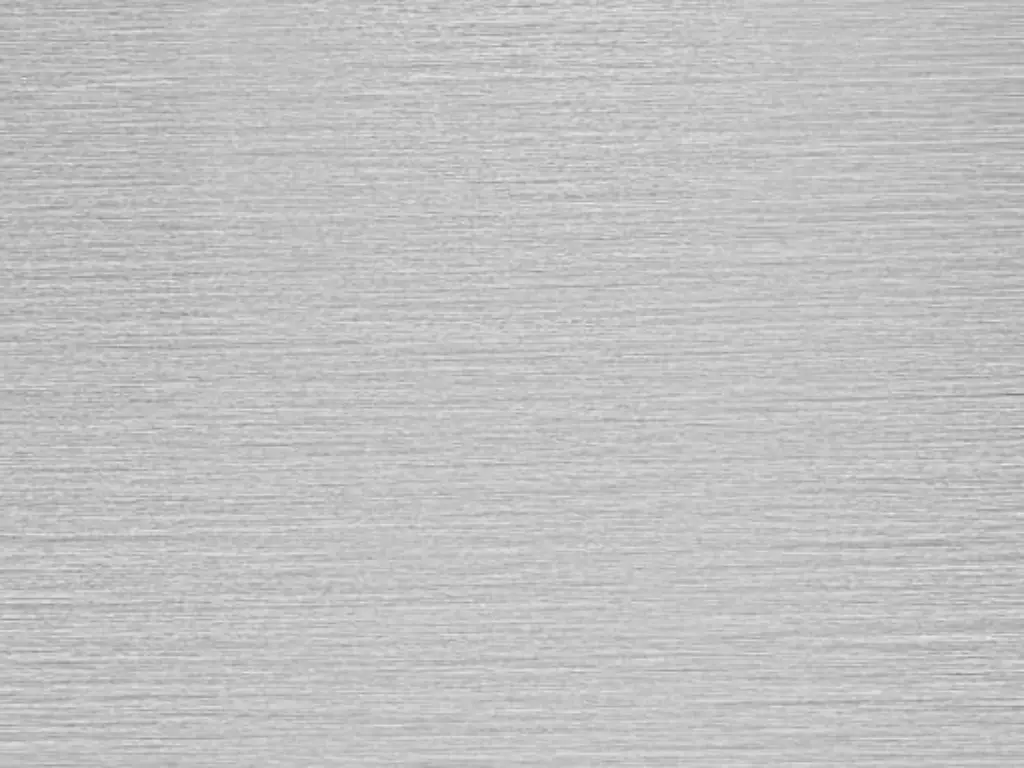
サテン・ステンレス・スチール: サテン仕上げは、サテン仕上げとポリッシュ仕上げの中間で、光沢を抑えたソフトな光沢が特徴です。サテン仕上げは、サテン仕上げより少し滑らかで、ポリッシュ仕上げより反射が少ない。ほとんどのインテリアスタイルに合う、普遍的でスタイリッシュなソリューションです。
仕上げとメンテナンスへの影響
仕上げをお考えの際は、キャビネットの金物をどのくらいの頻度でお手入れされたいかをお考えください。
- ブラッシュドステンレススチール: 表面はざらざらしており、指紋や汚れ、細かい傷を隠すのに優れています。そのため、キッチンの引き出しやパントリーの扉など、人の出入りが多い場所に最適です。お手入れは簡単で、マイクロファイバークロスで軽く拭くだけです。
- ポリッシュ仕上げのステンレススチール: 鏡面仕上げのステンレススチールは美しいが、指紋や汚れがつきやすい。光沢のあるきれいな外観を保つためには、頻繁にクリーニングをする必要がある。しかし、磨き上げると、他の仕上げにはない輝きを放ちます。
- サテン・ステンレス・スチール: この仕上げは、両者のいいとこ取りをしたものだ。ポリッシュ仕上げほど汚れは目立ちませんが、ブラッシュ仕上げよりも滑らかで洗練されています。より滑らかな仕上げの外観を望む住宅所有者と、より簡単なメンテナンスを望む住宅所有者の間の優れた妥協点です。
完璧なフィットのためのハードウェアのサイズ
キャビネットの金具の適切なサイズを選ぶことは、通常無視されがちな重要なプロセスです。キャビネットの引手やステンレスノブは、適切なプロポーションと快適な使い心地を実現するために、適切なサイズを選びます。
プロポーションは、金具のサイズの黄金律です。金具は、引き出しや扉に圧迫感を与えず、どっしりとした印象を与えるものでなければなりません。これがガイドラインの一部です:
- 引き出し用: 引手の幅は、引き出しの幅の約3分の1が目安です。24インチの引き出しの場合、8インチの引き手が最適です。大きな引き出し(30インチ以上)の場合は、バランスと開けやすさを考えて、引き手を2本にしてもよいでしょう。
- キャビネット・ドア用: ノブや引き手は1つが一般的。ほとんどのドアはノブがあれば安全です。引き手の場合、もう一度3分の1ルールを適用できますが、ドアの幅ではなく高さを測ります。
- 中心から中心への測定: 引き手の2つのネジ穴の間の寸法。最も重要な引き手の寸法です。金具を交換する際には、必ず現在の穴を正しく測定するか、新しい穴を開ける際にはテンプレートを使用してください。3、4、6、8インチなどが一般的なサイズです。
キッチンに合ったスタイルを見つける
ステンレスキャビネットの金具のスタイルは、部屋全体の雰囲気を左右します。ステンレススチールはそれ自体がモダンな素材ですが、その形状はほぼどんなデザインスタイルにも合うように変更することができます。
モダン、トラディショナル、その中間
- モダン&コンテンポラリー: シンプルなラインとミニマルなデザインが特徴です。モダンデザインの特徴は、直線的なバーの引き手とシンプルな円筒形のステンレス製ノブ。これらのアイテムは、フラットパネルキャビネットやステンレススチールの電化製品と相性がよく、すっきりとした印象を与えます。
- 伝統的なものだ: 真鍮などの温かみのある金属は伝統的なデザインに使われることが多いが、ステンレスも適切な形と組み合わせれば効果的に使うことができる。カップ型の引手や鳥かご型のノブなど、エレガントなデザインを探してみましょう。これらのデザインは、伝統的な美しさを感じさせると同時に、ステンレスの強さを感じさせます。
- トランジショナル: このトレンディなスタイルは、両方の長所を併せ持つ。ファッショナブルすぎず、派手すぎないクラシックなスタイルを望む住宅所有者に最適です。シンプルな少しカーブした引き手や、つや消し仕上げのクラシックな丸いノブが、このスタイルに最もふさわしい美的感覚です。
ノブ、引き手、特殊金物
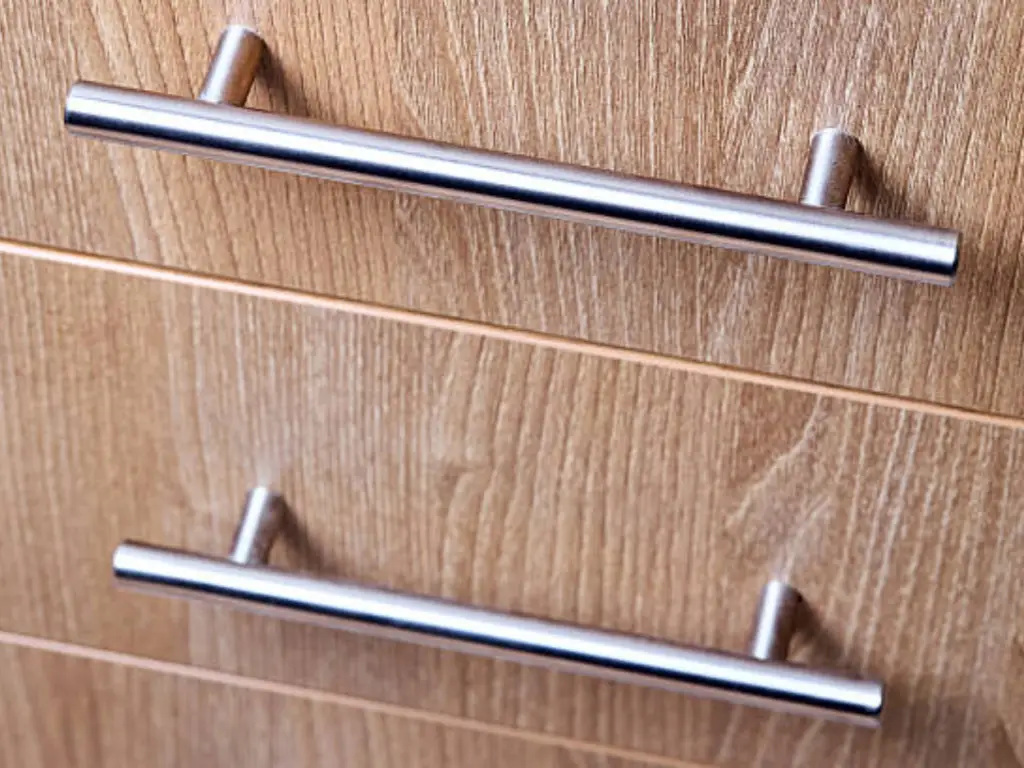
- ノブ: 単穴ファスナーなので、交換も取り付けも簡単。扉にも引き出しにも似合う、伝統的な万能オプションだ。キャビネットの扉は通常ステンレス製のノブで、引手は引き出しにのみ施されるため、視覚的な階層が美しくなります。
- プル: キャビネットの引手は2つ穴のデザインで、グリップが広く、重い扉や大きな引き出しを開けるときに快適です。一般的なバータイプの引手から、珍しいフィンガータイプの引手、半月型の引手など、さまざまな形やサイズがあります。
- 特殊ハードウェア: このカテゴリーには、引き出しの前板の上部または側面に取り付け、取っ手のない滑らかな外観を実現するエッジ引手など、特別な選択肢があります。ウルトラモダンやミニマルなデザインで、見た目のごちゃつきを抑えたい場合に最適です。
機能的な金物を選ぶ:蝶番と引き出しのスライド
キャビネット・プロジェクトを成功させるには、見た目の美しさだけでなく、完璧な性能が求められます。それを実現するのが、ヒンジと引き出しスライドです。
キャビネット・ヒンジ
ヒンジは、キャビネットの扉の開閉や位置合わせを決める重要なパーツです。長期的に機能させるためには、高品質のヒンジに投資することが不可欠です。
- ドアのたるみを防ぎます:ドアの重量は、丈夫なヒンジ、特にステンレススチールなどの耐久性のある素材で作られたヒンジによって支えられ、何年使用してもドアが完璧に揃った状態を保つことができます。
- スムーズで静かな機能:新しいヒンジにはソフトクローズなどの新機能が搭載され、ドアがバタンと閉まることがなく、環境に静かな贅沢を提供します。
- 耐腐食性:ステンレススチールヒンジは、キッチンやバスルームのような湿気の多い場所では錆や腐食に強く、常に信頼性が高く、見た目もきれいです。
キャビネット・ヒンジの種類
| ヒンジタイプ | 説明と最適な使用方法 |
| 隠しヒンジ (ヨーロピアンヒンジ) | キャビネットの扉を閉めると完全に見えなくなり、すっきりとしたシームレスでモダンな外観になります。扉の高さを完璧に調整できます。 最適:モダン、フレームレス、現代的なキャビネット。 |
| 伝統的なバットヒンジ | 古典的でシンプルな2枚葉ヒンジ。扉を閉めるとヒンジの一部(バレル)が見える。 最適:トラディショナル、ファームハウス、ユーティリティ・スタイルのキャビネットで、金具が美観の一部である場合。 |
| セミシールドヒンジ | ドアを閉めたときにヒンジの装飾ナックルだけが見えるハイブリッドスタイルで、「ウィング」は内側に取り付けられている。 最適です:伝統的または過渡的なスタイルのフェースフレームキャビネット。 |
| オーバーレイ・ヒンジ | キャビネット・フレームの上に「オーバーレイ」するドア用にデザインされています。ドアとフレームの端に見えます。 最適です:ユーティリティ・ルームや低予算のリフォームで一般的な、フェイスフレーム・キャビネットの費用対効果の高いソリューション。 |
引き出し スライド:スムーズな滑走の確保
引き出しの出し入れを可能にする機構は、引き出しスライド(またはランナー)と呼ばれます。スライドが適切かどうかで、使い勝手は大きく変わります。
- 重いものを支える良質なスライド、特にボールベアリングを使用したスライドは、重い荷重を支えることができるので、鍋やフライパン、食器など重いものを収納する引き出しに最適です。
- フル&イージーアクセス:フルエクステンションスライドにより、引き出しを完全に引き出すことができ、一番奥の引き出しも含め、すべての引き出しの中身に手が届きます。
- ユーザーエクスペリエンスの向上:ソフトクローズなどの新技術により、引出しがバタンと閉まることはありません。また、プッシュ・トゥ・オープン・システムは、ミニマルなデザインに取っ手のないすっきりとした外観をもたらします。
- 長期にわたる耐久性を提供:ステンレススチール製のスライドは耐久性に不可欠であり、スムーズで静かな滑りを提供し、生涯にわたって使用できる耐摩耗性と耐腐食性を備えています。
引き出しの種類 スライド
| スライドタイプ | 説明と最適な使用方法 |
| ボールベアリング・スライド | 列のスチール製ボールベアリングを使用し、非常に滑らかで静かなグライディングモーションを提供します。一般的に、より高い負荷容量とフルエクステンションを提供します。 最適:使用頻度の高いキッチンの引き出し、頑丈な収納、オフィス家具、あらゆる高級キャビネット。 |
| ローラー・スライド (エポキシスライド) | より基本的で経済的なオプションで、ナイロン製またはプラスチック製のローラーを使用します。通常、部分伸展式(3/4伸展)で、重量制限が低い。 最適:軽作業用、低予算のプロジェクト、または古い家具の交換用金具。 |
| アンダーマウント・スライド | 側面ではなく、引き出しボックスの底面に取り付けられているため、引き出しを開けた状態ではまったく見えません。これにより、可能な限りすっきりとした外観を実現しています。 最適シームレスな外観が最優先される、ハイエンドのカスタム・キャビネットやモダンなデザイン。 |
| サイドマウント・スライド | 最も一般的なタイプで、引き出しボックスの側面とキャビネットの内側に直接取り付けられている。ボールベアリング・スライドがこのタイプの主な例です。 最適:キッチンから作業場まで、キャビネットのほとんどの用途。 |
プロフェッショナルな外観のためのシームレスな取り付け
キャビネットの金具の取り付けは大変そうに見えるかもしれませんが、適切な道具と多少の忍耐があれば、プロフェッショナルな仕上がりにすることができます。
ツールll 必要だ:
| 工具 | 主な目的 | 選択と使用のヒント |
| ドリル | キャビネットの扉や引き出しの前板に、取り付けネジに必要な穴を開けるのに使用する。 | ビットサイズ:金具に付属しているネジの直径にぴったり合っていること。小さすぎるとネジが入らず、大きすぎると穴が緩くなる。 スピードコントロール:正確な穴あけができるよう、低速からスタート。 コードレスドリルが最も便利だ。 |
| テープメジャー | ドアや引き出しの寸法を正確に測定し、引手やノブの中心取り付け位置を決定する。 | 測定値を安定させるには、ロック機能付きの巻尺が望ましい。 必ず端から測り、正確を期すこと(例えば、ミリメートル単位や1/16インチ単位)。 |
| 鉛筆またはマーキングツール | 寸法を測った後、キャビネットの表面に正確な穴あけポイントをマークする。 | 簡単に消せる跡には、削った鉛筆を使う。 濃い色のキャビネットの場合は、白かシルバーのマーキングペン、または画家用のテープが効果的だ。 |
| ハードウェア取り付け治具またはテンプレート | 調整可能なガイドにより、複数のドアや引き出しの穴あけポイントを素早く正確に、一貫して特定できます。 | 強くお勧めします!特にハンドルの多いプロジェクトでは、すべての金具が水平で均一な間隔になるようにします。 購入の際は、調整可能な範囲がお使いの金具の穴間隔に対応していることを確認してください。 |
| ドライバー | ノブや引手を固定するネジを手動で締めるために使用する。 | 正しいビットを選ぶ:ドライバーのヘッドがネジの溝タイプ(プラス、マイナスなど)とサイズに合っていることを確認し、ネジや金具を剥がさないようにする。 手締め:最終的な締め付けには、手動ドライバーを使用するのが最善です。 |
| ペインターテープ | 掘削エリアに塗布することで、いくつかの利点がある: 1.ドリルによる木材表面の割れや欠けを防ぎます。 2.キャビネットに直接印をつけるのではなく、テープに印をつけることができます。 3.ドリルビットに滑り止めを提供します。 | 剥がすときに塗装や仕上げを傷めない、粘着力の弱い、または中程度のペインターテープを選ぶ。 穴を開ける前に、テープを表面にしっかりと押し付ける。 |
ステップ・バイ・ステップ・ガイド
完璧な取り付けをするためには、まず穴を正しくマーキングすることから始めましょう。すべてのノブや引き手が同じ位置に取り付けられ、統一感のある外観になるよう、金具取り付け用の治具やテンプレートを使うことを強くお勧めします。ノブには1箇所、引き手には中心から中心までの寸法を表す2箇所に印を付けます。そして、ドリルビットが滑らないように、またキャビネットの仕上げを傷つけないように、印をつけた場所をペインターテープで覆います。正確さを増すために、最初は小さめの下穴を開けておくとよいでしょう。穴を開けたら、付属のネジをキャビネットや引き出しの内側に押し込んで、金具をねじ込みます。ネジはきっちりとねじ込みますが、締めすぎるとキャビネットの木材を傷つけてしまうので、締めすぎないようにしましょう。
このプロセスにより、ハードウェアが確実に固定されるだけでなく、一貫して配置され、プロジェクトが洗練されたプロフェッショナルな外観になります。
適切なケアでハードウェアを美しく保つ
ステンレススチールのメンテナンスの手間の少なさは、大きな利点のひとつです。しかし、ちょっとしたお手入れをするだけで、キャビネットの金物を最高の状態に保つことができます。
| ケアレベル | 手順とステップ | 主な検討事項 |
| デイリーケア | 乾いた柔らかいマイクロファイバークロスで金具を拭くだけ。 | 通常、日常的なホコリや指紋を取り除くにはこれで十分だ。 日常的な手入れに水やクリーナーは必要ない。 |
| ディープ・クリーニング | 1.溶液を作る:ぬるま湯にマイルドな食器用洗剤を数滴加えて混ぜる。 2.きれいにする:柔らかい布を溶液に浸し、絞ってから金具を優しく拭いてください。 3.すすぎ:水だけで湿らせた別の清潔な布で、石鹸の残留物を拭き取ります。 4.乾燥: 清潔な乾いた布で、直ちに金具を完全に乾燥させる。 | つや消し仕上げの場合は、微細な傷を避けるため、必ず木目の方向に拭いてください。 ウォータースポットを防ぎ、輝きを保つためには、徹底した乾燥が重要である。 この方法は、頑固な汚れを落としたり、光沢を取り戻したりするのに理想的だ。 |
| 避けるべきこと | 避けるべき化学物質: 研磨クリーナー(パウダー、粒状クリーム) 塩素系製品(漂白剤など) スチールウール 過酷な化学溶剤 避けるべき道具: 研磨パッド ざらざらしたスポンジ | これらのものは、ハードウェアの表面に永久的な傷をつける可能性があります。 過酷な化学薬品はステンレスの不動態保護層にダメージを与え、変色や錆の原因になることがあります。 |
適切なお手入れをすれば、ステンレス・スチール製のノブ、キャビネットの引き手、ドアの取っ手は、何年も先まで美しく機能的であり続けるでしょう。
空間を格上げする:マクサベのハードウェアが賢い選択である理由
家具金物サプライヤーの選定は、製品の品質とサプライチェーンの安定性の観点から不可欠です。マクサベはB2Bの家具金物専門メーカーであり、品質のばらつきや配送の不安定さといった業界の典型的な悩みを直接解決します。当社は85%自動化された作業場と最先端の亜鉛メッキラインを使用し、年間5億個の蝶番と3,000万個の引き出しスライダーセットといった巨大な生産能力を達成しています。99.2%の製品認定率と100%の品質保証があります。この精密なエンジニアリングと強力な製造能力により、当社のパートナーは、プロジェクトごとに耐久性のある最高のステンレススチール製キャビネットハードウェア、ヒンジ、スライダーを得ることができます。
卓越した製造技術に加え、当社は実際のビジネス上のメリットも提供します。当社の新しい梱包技術は、カートンサイズを20%削減し、コンテナあたりの運賃を最大35%節約します。当社はサプライヤーではなく、お客様の業務効率と製品価値の向上に尽力する戦略的パートナーです。大規模プロジェクトで使用する耐久性の高いステンレスノブが必要な場合も、カスタムデザインのドアハンドルが必要な場合も、お客様のニーズに合った信頼性の高いソリューションをご用意しています。マクサベとのコラボレーションにより、性能と見栄えが良く、手頃な価格のハードウェアで家具をアップグレードしましょう。
当社の高性能ハードウェア・ソリューションがお客様のビジネスにどのように役立つかについては、https://www.maxavegroup.com/ をご覧ください。
ステンレス製金物に関するご質問にお答えします。
Q: ステンレス製の金具は錆びますか?
A: ステンレス・スチール、特に304グレードは錆に非常に強い。錆は通常、酸化皮膜が破壊されるか、塩素のような刺激の強い化学物質にさらされたときに発生します。ステンレススチール製の金具は、適切なお手入れと刺激の強いクリーナーを使用すれば、錆びることはありません。
Q: キッチンでノブと引き手を組み合わせて使えますか?
A: もちろん!人気の高いデザインオプションです。すべてのキャビネットの扉にノブを、すべての引き出しに引手をつけるのが標準です。こうすることで、バランスの取れた美しい外観になるだけでなく、各タイプのキャビネット開口部に最高の機能性を提供します。
Q: どのようにハードウェアを家電製品に合わせるのですか?
A: これは一般的な心配事です。ステンレススチール製のキャビネット金具は、ステンレススチール製の電化製品によく合います。統一感のある外観を実現するには、通常、つや消しステンレススチールの仕上げが最も適しています。このタイプのステンレススチールのマットな仕上げは、ほとんどの現代的な電化製品の表面によくなじむ可能性が高いからです。
キャビネットの強化に関する最終的な考え
適切なキャビネット金物は、単なる仕上げではなく、スタイルの表明であり、品質の約束です。ステンレススチールの等級や仕上げ、サイズ、メンテナンスなど、ステンレススチールの基本をじっくり学ぶことで、一生ものの選択ができるようになります。引き手のミニマルな美しさ、ステンレスノブのクラシックでシンプルなデザインなど、金物は空間の個性と機能性を左右する重要な要素です。評判の高い会社がつくった高品質の金物を選ぶことで、ドアハンドルやキャビネットの引手が、今、驚くほど美しく見えるだけでなく、何年経っても感動を与えてくれることを心に留めておくことが大切です。






